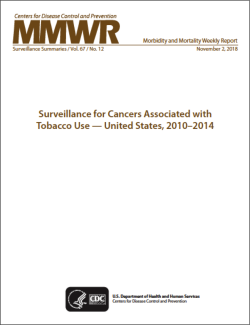Surveillance for Cancers Associated with Tobacco Use — United States, 2010–2014

Abstract
Problem/Condition: Tobacco use is the leading preventable cause of cancer, contributing to at least 12 types of cancer, including acute myeloid leukemia (AML) and cancers of the oral cavity and pharynx; esophagus; stomach; colon and rectum; liver; pancreas; larynx; lung, bronchus, and trachea; kidney and renal pelvis; urinary bladder; and cervix. This report provides a comprehensive assessment of recent tobacco-associated cancer incidence for each cancer type by sex, age, race/ethnicity, metropolitan county classification, tumor characteristics, U.S. census region, and state. These data are important for initiation, monitoring, and evaluation of tobacco prevention and control measures.
Period Covered: 2010–2014.
Description of System: Cancer incidence data from CDC’s National Program of Cancer Registries and the National Cancer Institute’s Surveillance, Epidemiology, and End Results program were used to calculate average annual age-adjusted incidence rates for 2010–2014 and trends in annual age-adjusted incidence rates for 2010–2014. These cancer incidence data cover approximately 99% of the U.S. population. This report provides age-adjusted cancer incidence rates for each of the 12 cancer types known to be causally associated with tobacco use, including liver and colorectal cancer, which were deemed to be causally associated with tobacco use by the U.S. Surgeon General in 2014. Findings are reported by demographic and geographic characteristics, percentage distributions for tumor characteristics, and trends in cancer incidence by sex.
Results: During 2010–2014, approximately 3.3 million new tobacco-associated cancer cases were reported in the United States, approximately 667,000 per year. Age-adjusted incidence rates ranged from 4.2 AML cases per 100,000 persons to 61.3 lung cancer cases per 100,000 persons. By cancer type, incidence rates were higher among men than women (excluding cervical cancer), higher among non-Hispanics than Hispanics (for all cancers except stomach, liver, kidney, and cervical), higher among persons in nonmetropolitan counties than those in metropolitan counties (for all cancers except stomach, liver, pancreatic, and AML), and lower in the West than in other U.S. census regions (all except stomach, liver, bladder, and AML). Compared with other racial/ethnic groups, certain cancer rates were highest among whites (oral cavity and pharyngeal, esophageal, bladder, and AML), blacks (colon and rectal, pancreatic, laryngeal, lung and bronchial, cervical, and kidney), and Asians/Pacific Islanders (stomach and liver). During 2010–2014, the rate of all tobacco-associated cancers combined decreased 1.2% per year, influenced largely by decreases in cancers of the larynx (3.0%), lung (2.2%), colon and rectum (2.1%), and bladder (1.3%).
Interpretation: Although tobacco-associated cancer incidence decreased overall during 2010–2014, the incidence remains high in several states and subgroups, including among men, whites, blacks, non-Hispanics, and persons in nonmetropolitan counties. These disproportionately high rates of tobacco-related cancer incidence reflect overall demographic patterns of cancer incidence in the United States and also reflect patterns of tobacco use.
Public Health Action: Tobacco-associated cancer incidence can be reduced through prevention and control of tobacco use and comprehensive cancer-control efforts focused on reducing cancer risk, detecting cancer early, and better assisting communities disproportionately affected by cancer. Ongoing surveillance to monitor cancer incidence can identify populations with a high incidence of tobacco-associated cancers and evaluate the effectiveness of tobacco control programs and policies. Implementation research can be conducted to achieve wider adoption of existing evidence-based cancer prevention and screening programs and tobacco control measures, especially to reach groups with the largest disparities in cancer rates.